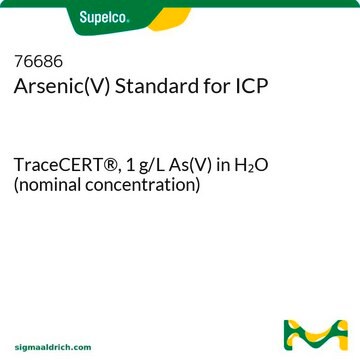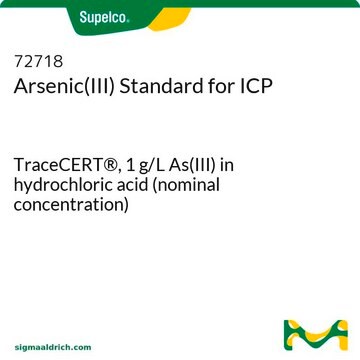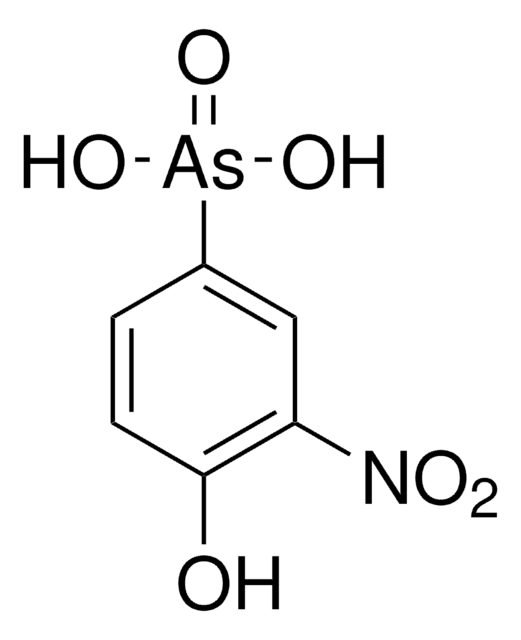11093
Arsenobetaine
purum p.a., ≥95.0% (NMR)
Synonym(s):
2-(Trimethylarsonio)acetate
Sign Into View Organizational & Contract Pricing
All Photos(1)
About This Item
Empirical Formula (Hill Notation):
C5H11AsO2
CAS Number:
Molecular Weight:
178.06
Beilstein:
3933180
MDL number:
UNSPSC Code:
12352100
PubChem Substance ID:
NACRES:
NA.22
Recommended Products
grade
purum p.a.
Quality Level
Assay
≥95.0% (NMR)
form
solid
SMILES string
C[As+](C)(C)CC([O-])=O
InChI
1S/C5H11AsO2/c1-6(2,3)4-5(7)8/h4H2,1-3H3
InChI key
SPTHHTGLGVZZRH-UHFFFAOYSA-N
Looking for similar products? Visit Product Comparison Guide
Application
Arsenobetaine has been used to investigate the biochemical response of mice (Mus musculus) to inorganic arsenic exposure using liver as the target organ.
Packaging
Bottomless glass bottle. Contents are inside inserted fused cone.
Signal Word
Danger
Hazard Statements
Precautionary Statements
Hazard Classifications
Acute Tox. 3 Inhalation - Acute Tox. 3 Oral - Aquatic Acute 1 - Aquatic Chronic 1
Storage Class Code
6.1C - Combustible acute toxic Cat.3 / toxic compounds or compounds which causing chronic effects
WGK
WGK 3
Flash Point(F)
Not applicable
Flash Point(C)
Not applicable
Personal Protective Equipment
dust mask type N95 (US), Eyeshields, Gloves
Choose from one of the most recent versions:
Already Own This Product?
Find documentation for the products that you have recently purchased in the Document Library.
Customers Also Viewed
R Alborough et al.
Scientific reports, 10(1), 3160-3160 (2020-02-23)
Felids have a high incidence of chronic kidney disease (CKD), for which the most common renal lesion is chronic interstitial nephritis (CIN). CIN can be induced by tissue oxidative stress, which is determined by the cellular balance of pro- and
Ana Navas-Acien et al.
Environmental health perspectives, 117(9), 1428-1433 (2009-09-15)
Arsenic exposure in drinking water disproportionately affects small communities in some U.S. regions, including American Indian communities. In U.S. adults with no seafood intake, median total urine arsenic is 3.4 microg/L. We evaluated arsenic exposure and excretion patterns using urine
Toni Llorente-Mirandes et al.
Chemosphere, 81(7), 867-875 (2010-10-01)
The determination of arsenic compounds in algae collected on the Catalan coast (Western Mediterranean) is reported. Ten algae species and the seagrass Posidonia oceanica were analyzed. Total arsenic in the samples was determined by microwave digestion and inductively coupled plasma
Takashi Kunito et al.
Reviews of environmental contamination and toxicology, 195, 31-69 (2008-04-19)
Although there have been numerous studies on arsenic in low-trophic-level marine organisms, few studies exist on arsenic in marine mammals, seabirds, and sea turtles. Studies on arsenic species and their concentrations in these animals are needed to evaluate their possible
Association of Arsenic Exposure With Cardiac Geometry and Left Ventricular Function in Young Adults.
Gernot Pichler et al.
Circulation. Cardiovascular imaging, 12(5), e009018-e009018 (2019-05-08)
Arsenic exposure has been related to numerous adverse cardiovascular outcomes. The aim of this study was to investigate the cross-sectional and prospective association between arsenic exposure with echocardiographic measures of left ventricular (LV) geometry and functioning. A total of 1337
Our team of scientists has experience in all areas of research including Life Science, Material Science, Chemical Synthesis, Chromatography, Analytical and many others.
Contact Technical Service










